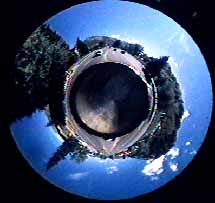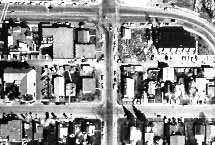|
|

© copyright 2003 Michael P.
Hamilton, Ph.D.
The magic mirrors of virtual Aspen

September 18, 1982:
The jet was flying somewhere over New Mexico when clouds
engulfed the plane and stole my view of the arid landscapes below.
Turning instead to my briefcase, I pulled out the latest copy of Byte
magazine, a journal for computer experimenters. I read a review of
the brand new Apple II computer, and an article about programming
in a computer language called BASIC. It was fascinating, having programmed
mainframe computers in graduate school, this new trend in desktop
computers had a clear advantage in cost over those massive machines.
Yet the power of these little devices, much like the simplistic computers
I constructed in my dad's workshop, continued to appear to me to be
suitable for the electronic hobbyist rather than the serious scientist.

hemispherical camera images taken along Aspen streets
Another article described a promising technology called
interactive video. Up to 54,000 separate photographs are stored on each
side of a 12 inch diameter laserdisc, and these images can be individually
retrieved and displayed on a TV screen in about 3 seconds or less. A
project to test the technology was developed by Andy Lippman and John
Borden at the Massachusetts Institute of Technology (MIT). They mounted
four 16 mm Bolex movie cameras on the roof of a truck, each pointed
at right angles to one other, and motor-activated shutters would repeatedly
snap a single movie frame every five foot the truck traveled. They proceeded
to drive all the major streets in Aspen Colorado, documenting their
progress through the city as a collection of thousands of overlapping
images. In addition, they filmed stills and short movies of interesting
storefronts and interiors, menus from popular restaurants, historical
artifacts, and interviews with city officials. Borden built another
device that automated the controls of a movie camera mounted on a copy
stand. Using this system they recorded hundreds of aerial photographs,
blueprints and road maps of Aspen at 20 different degrees of zoom and
position to film.
When the team of professors and students returned to
MIT, there began the tedious task of transferring hundreds of thousands
of movie frames of information to three laserdiscs. Once accomplished,
they programmed software that would interactively control the display
of their massive collection of video stills and movies based upon
a computerized map of the streets of Aspen.

video stills of air photographs of Aspen, Colorado
The ultimate project allowed someone to sit in front
of a computer monitor viewing an aerial photograph of Aspen. Along the
bottom of the screen were superimposed a series of colorful buttons
or icons of left and right pointing arrows, a stop sign, the words forward
and backwards, a magnifying glass and a couple of other symbols. The
surface of the monitor was sensitive to your finger, so when you touched
the icon for "magnify," the aerial photo instantly enlarged
to present a closer view. Touch any one of the streets and your perspective
jumped from a bird's-eye view to that of the ground, standing on the
same street that you selected. Now the fun begins. Touch the forward
icon to begin traveling down the street, stop at an intersection and
touch the right or left arrow to immediately make the appropriate turn.
At any time you could stop, look in any direction, touch a storefront
and receive information about the place, or even move into the building
and look around the interior.
My briefcase was filled with the final draft of my dissertation
as I was headed back to Ithaca, New York from Idyllwild to complete
the final examination for my doctoral degree in Natural Resources. The
article about virtual Aspen and the potential of using the mirror-like
laserdisc to build a visual database set a seed in my mind for how I
might take my years of studies about natural history of the San Jacinto
Mountains and electronically organize this knowledge so that it becomes
interactively available to thousands, and perhaps millions, of people.
From this single event I was set on a course that would influence my
professional career for decades to come.

previous journal entries
|

